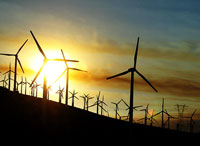Public support for immediate action on climate change is strong—and growing stronger. At the same time, volatile fuel prices and economic instability have pushed energy policy to the top tier of the national agenda in Canada and the United States.
A promising approach for accelerating the shift to a clean-energy economy is a market-based system called “cap and trade.” A cap-and-trade system would put responsible limits on climate-warming pollution, while creating incentives for a cleaner, more efficient energy economy.
National and regional leaders in Canada and the United States are recommending cap and trade as a feasible, effective solution for curbing climate change. The Western Climate Initiative (WCI) brings leaders from seven states and three provinces together to take charge of the region’s energy future. Sightline has worked closely with WCI policymakers to design a cap-and-trade system for our region.
This fact sheet answers some of the questions that frequently come up about the system.
Why do we need climate policy?
Climate change is one of the greatest challenges of our time. The good news is that smart solutions are at hand to turn the challenge around. And climate solutions go hand in hand with solutions to create jobs, stabilize energy prices, and rebuild our economy.
The science: According to a recent study by the Rocky Mountain Climate Institute and the NRDC, the impacts are more profound in the Western United States than in the East, and we’re already feeling them. Science tells us that, to avoid the most dangerous impacts of global warming, America and the world must take immediate action to reduce emissions of global warming pollutants. In the United States, that means halting the growth in global warming emissions now, reducing emissions by at least 15 percent by 2020, and achieving reductions of at least 80 percent by mid-century.
The solutions: Currently there is no charge or fee for polluting the atmosphere with carbon emissions. It’s a free dumping ground, but the costs to our climate, our economic stability, and our health are enormous. The good news is that we have existing technology and boundless ingenuity to reduce the threat of global warming. But voluntary pollution reductions aren’t happening fast enough. If current trends don’t change, US greenhouse gas emissions are projected to increase as much as 35 percent by 2030, according to an analysis of US government forecasts.1 Smart climate policy can help reverse this trend, while at the same time taking control of our energy future and unhitching family budgets and our economy from the oil-economy rollercoaster.
Market-based policy solutions like cap and trade put a long-overdue price tag on pollution. The result is a clear financial incentive for efficiency and innovation and a means of rewarding those who decrease global warming pollution and cut our dependency on fossil fuels. A cap is the surest way to reach crucial climate goals and shift to a prosperous, and more stable energy economy — while giving maximum flexibility to businesses and energy producers.
Why cap and trade?
 Cap and trade has emerged as the most popular climate policy solution. It’s advocated by President Barack Obama, among other national-level leaders, and by Western governors participating in the Western Climate Initiative. This popularity is due to several key advantages:
Cap and trade has emerged as the most popular climate policy solution. It’s advocated by President Barack Obama, among other national-level leaders, and by Western governors participating in the Western Climate Initiative. This popularity is due to several key advantages:
- It’s tested and proven: A cap and trade system worked to cheaply and efficiently reduce acid rain in the United States in the 1990s.
- It’s cost effective: A cap provides market incentives to steadily reduce pollution in a cost-effective and efficient manner, encouraging a healthy shift away from the instability and insecurity of fossil fuels.
- It’s economically sound: With a firm cap, pollution levels are driven down gradually and the economy adjusts through fuel-efficiency and increased renewable energy resources like solar and wind power. Cap and trade gives businesses a recipe for success in the new energy economy: maximum flexibility, clear and feasible goals, and a predictable time line.
- It’s a prudent, long-term investment: The key to our long-term prosperity and a stable economy is a shift away from oil. This shift can work for businesses and consumers alike, allowing us to take charge of rising energy costs and invest in new technologies and ensuring a smooth transition. Right now, we’re sending billions of dollars a year out of local economies to pay for imported oil.
- And most importantly, the cap is a solid guardrail that keeps us moving forward on a predictable path to success: There’s no policy measure that can substitute for setting a solid cap on the greenhouse gas emissions that are allowed into the atmosphere; it’s our firm guarantee that we will meet crucial targets.
How does cap and trade work?
This market-based system rewards innovation and efficiency and generates revenue that can minimize impacts on consumers and fuel crucial research-and-development efforts. The cap establishes the amount of climate-warming pollution we will allow in any given year. It starts high and declines incrementally in subsequent years. These gradual reductions let the economy adjust. Here are the basic steps:
- First, we get a handle on existing greenhouse gas emissions. For fossil fuels, the easiest option is to track their fuels upstream, or at the point where they enter the region’s economy (the coal mine, the oil tanker, the well head).2 Since fossil fuels represent about 85 percent of our region’s emissions, we’re off to a great start.3
- Second, we set a cap. We decide how much carbon pollution to allow and we require permits for greenhouse gas emissions. The total number of permits matches the cap we’ve established (generally, one permit for every ton of carbon dioxide), so that we can be sure that we achieve our emissions goals.
- Third, permits are obtained and traded. In the best system, permits are auctioned rather than given away for free to polluters. (See below for more details on permit allocations).
- Finally, the cap ratchets down over time. Each year, we put fewer emissions permits in circulation. Over time, alternative energy sources grow and become cheaper, efficiency gains continue, and we make progress towards our goals.
Why auction permits instead of giving them away?
Ideally, energy companies and major greenhouse-gas emitters pay for the privilege of polluting by participating in an open auction. There are plenty of varieties to the auction system, but generally, companies will purchase as many permits as they think they need. If they end up with too few or too many, the permit trading market will allow them to purchase additional permits from other companies or sell unneeded ones.
Here are a few reasons lawmakers and citizens should insist on auctioned permits:
- Economists agree that energy prices will go up by about the same amount, whether the permits are auctioned or handed out for free. The difference is that, when permits are auctioned, the revenue can be funneled to programs to help consumers cope with rising energy costs. If permits are given out for free, companies will raise prices and simply pocket the extra money at the expense of individual consumers. This is a lesson learned from the European carbon trading system, which gave away permits and unintentionally created big windfall profits for polluters. In that system, increased energy costs were passed on to consumers, but polluters kept the profits.
- With an auction system, communities gain a source of revenue to invest in clean energy, help consumers deal with rising energy costs, boost efficiency in homes and buildings, ease transitions for affected workers, and fund training in green-collar jobs. Auctioned permits let us take charge of price increases and ensure that the money recharges local economies rather than distant oil producers.
What does cap and trade mean for consumers?
Cap and trade doesn’t create any paperwork for families and small businesses. Only major fossil fuel oil companies and big industrial polluters and utilities will track their emissions and obtain permits. Quietly but effectively, the cap will reduce our emissions. Energy prices may rise (as they already are), but revenues from auctioned permits can counteract the effects of price increases through investments in efficiency rebates, direct tax credits, transit infrastructure, and building energy retrofits.
What happens to energy prices?
Fossil fuel prices are already rising due to basic supply and demand. They will likely continue to rise in a system where pollution has a price tag. But a well-designed “trading” system encourages efficiency, innovation, and least-cost solutions, which in the long term will reduce demand for dirty energy, make emerging clean technologies increasingly competitive, and help keep the price of energy down by decreasing demand.
Why not a carbon tax?
Unlike a tax, a cap guarantees that we reach specific emissions targets. Without a cap, climate-warming emissions may not fall as quickly as we need them to, particularly if population or income increases rapidly. The cap is like a sturdy guardrail that keeps us on the road to success.
What’s in play in the Northwest?
The Western Climate Initiative (WCI) has announced a goal of reducing overall emissions to 15 percent below 2005 levels by the year 2020, with a market-based cap and trade system to help achieve those targets. WCI includes Arizona, California, Montana, New Mexico, Oregon, Utah, Washington, British Columbia, and Manitoba as full participants. WCI recommendations for state and provincial legislation were issued in September 2008.
What’s in play in North America?
Between three regional agreements (WCI, the Northeast’s Regional Greenhouse Gas Initiative, and the Midwestern Climate Accord), as many as 20 US states and three Canadian provinces have adopted cap-and-trade strategies for reducing their greenhouse gas emissions.
Several bills to control emissions have recently been introduced in the US Congress, including “America’s Climate Security Act of 2007” (the Lieberman-Warner bill) which includes a cap-and-trade plan. Barack Obama has advocated cap-and-trade climate solutions. Finally, a recent US Supreme Court case has indicated that the Environmental Protection Agency already has the authority to regulate greenhouse gas emissions, meaning that if Congress does not act, a US president can.
Notes:
1 McKinsey & Company researchers working on a report for seven US-based companies and environmental NGOs, used the “reference” scenario in the US Energy Information Administration’s Annual Energy Outlook 2007 report as the foundation of its emissions reference case for emissions through 2030, supplementing that with data from Environmental Protection Agency and Department of Agriculture sources. Reducing Greenhouse Gas Emissions: How Much at What Cost?, December 2007.
2 Most companies would not have to report, only firms like petroleum importers or mining firms. That way, we’ll know how much coal, oil and natural gas we’re burning, without asking each household or small business to track consumption. For other climate-warming gases, such as methane and nitrous oxide, major emitters will keep tabs on their releases–as many already do.
3 For emissions that are harder to measure–carbon stored in forests and farm fields or the methane produced by landfills or cow manure–we can create incentives for good management. But these sectors won’t be part of the permit and trading program, at least at first.
See also:
Sightline’s Climate Policy Project
Sightline blog commentary on Western Climate Initiative’s cap-and-trade proposals
Cap and Trade 101: Federal Climate Policy Primer in Two Pages: an Executive Summary








